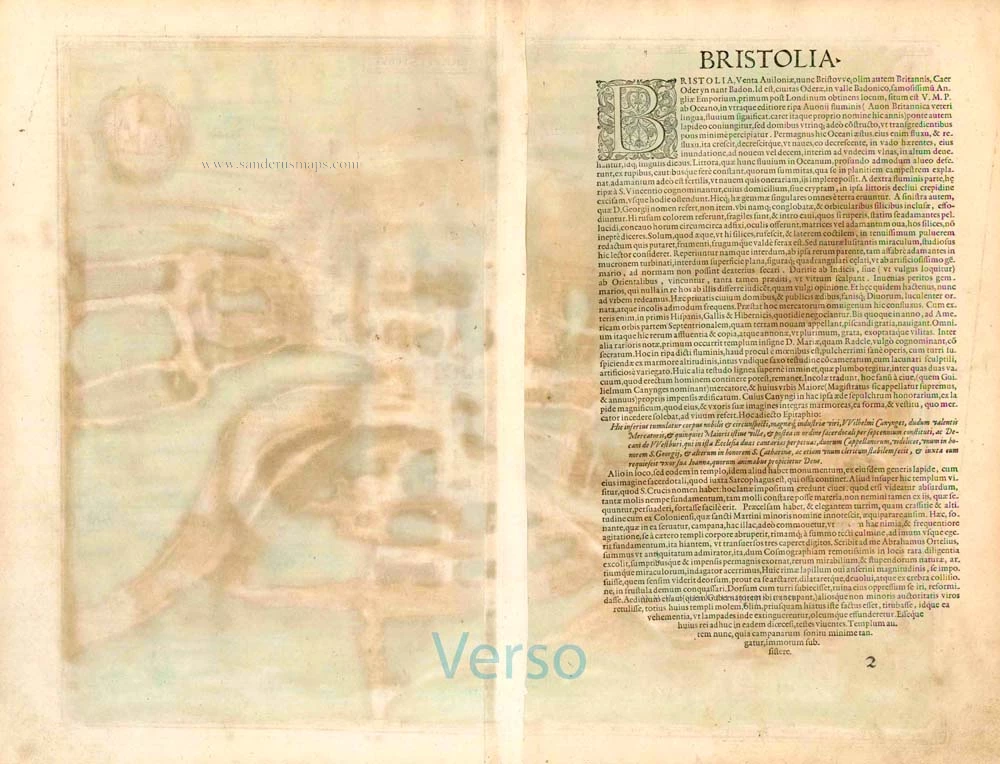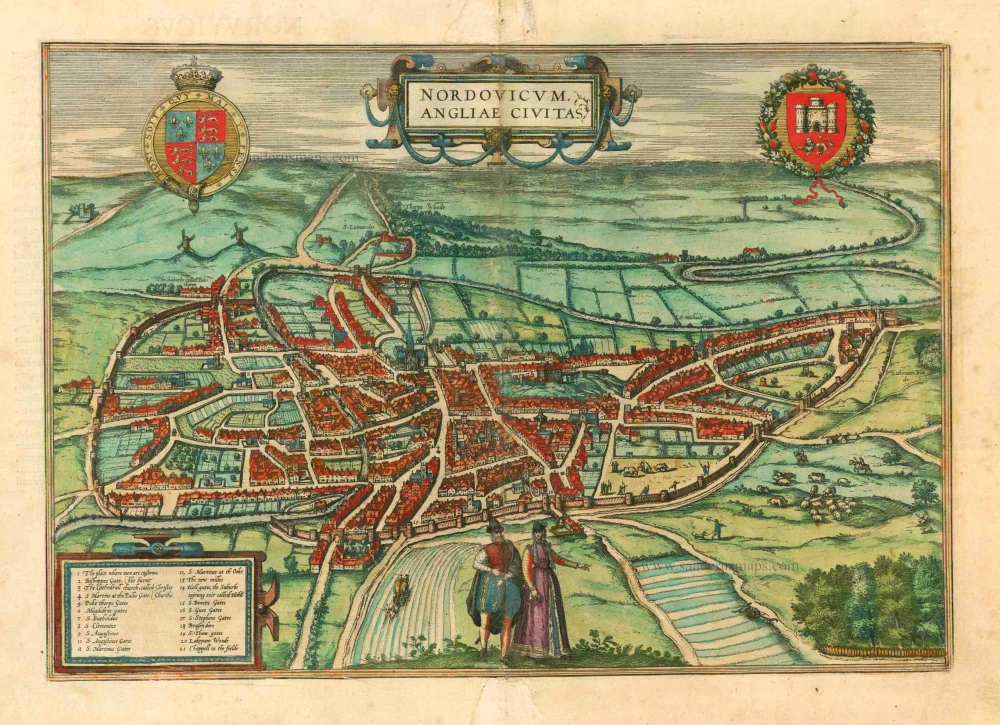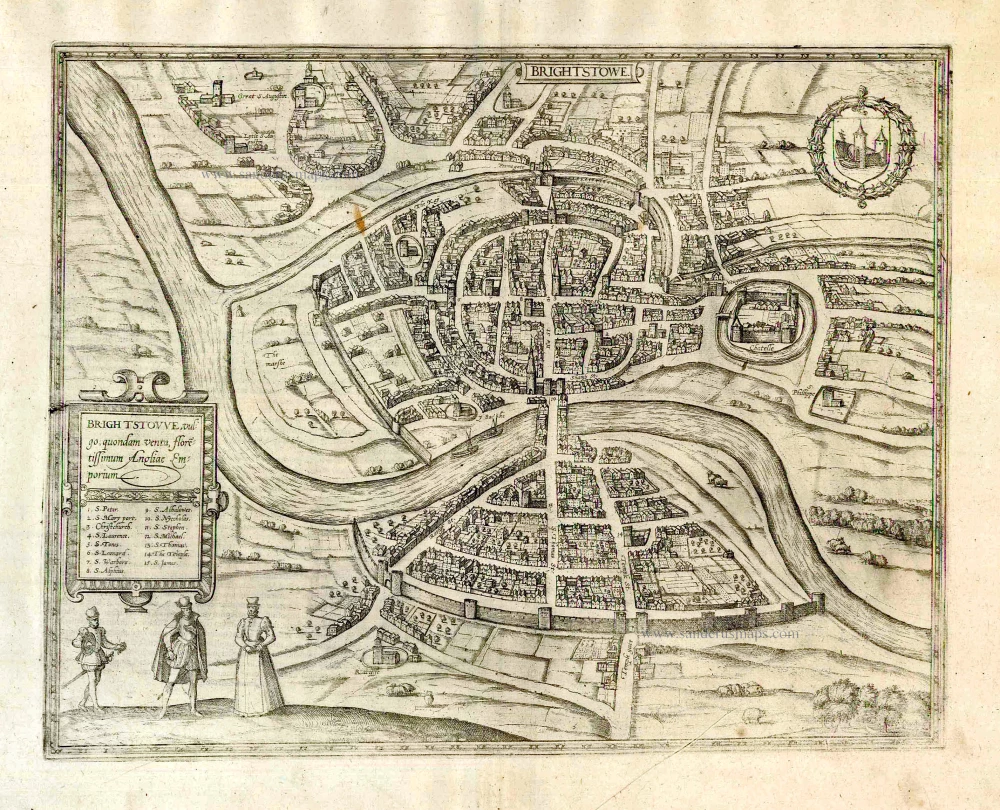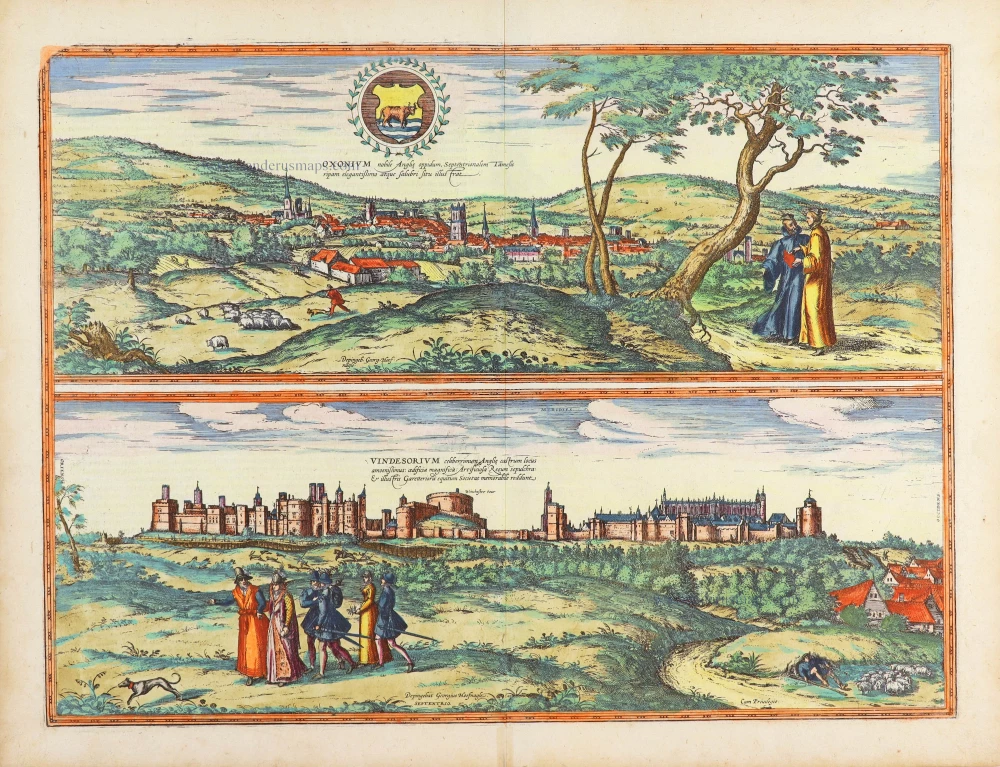Bristol, by Georg Braun & Frans Hogenberg. 1581
TRANSLATION OF CARTOUCHE TEXT: Brightstowe, in English Bristol; once a thriving English centre of trade.
COMMENTARY BY BRAUN: "Bristol is a well-known, and after London the most important, centre of trade in England, 5,000 paces away from the sea and built up along both side of the River Avon. Both parts of the city are linked by stone bridges lined with buildings on both sides, so that one doesn't notice when going over the bridge that it is one. The ocean in this region is very stormy, since the tides are very strongly felt. Because of plentiful fishing the fishermen set off twice a year to America, that is, to the northernmost part of the world, today called the New World."
The bird's-eye view depicts the trading city of Bristol, which is located by the sea in the southwest of England and is separated into two parts by the broad winding River Avon. In the background the small River Frome divides the city centre shown in the middle of the plate. In the foreground lies the southern suburb of Redcliffe. As a wool and cloth-trading city, Bristol, founded at the turn of the 11th century, took an increasing important role and was for centuries England's second most important city after London. The bridge gave the city its name early on: the Old English name Brycgstow means the "place at the bridge". The castle on the right, which is well fortified and has a moat, was erected under Norman rule. Bristol was the homeport of an important merchant fleet, which led to the founding of the renowned Society of Merchant Ventures; in 1497 the city became the departure point for John Cabot's expedition to North America.
Braun G. & Hogenberg F. and the Civitates Orbis Terrarum.
The Civitates Orbis Terrarum, also known as the 'Braun & Hogenberg', is a six-volume town atlas and the most excellent book of town views and plans ever published: 363 engravings, sometimes beautifully coloured. It was one of the best-selling works in the last quarter of the 16th century. Georg Braun, a skilled writer, wrote the text accompanying the plans and views on the verso. Many plates were engraved after the original drawings of a professional artist, Joris Hoefnagel (1542-1600). The first volume was published in Latin in 1572 and the sixth in 1617. Frans Hogenberg, a talented engraver, created the tables for volumes I through IV, and Simon van den Neuwel made those for volumes V and VI. Other contributors were cartographers Daniel Freese and Heinrich Rantzau, who provided valuable geographical information. Works by Jacob van Deventer, Sebastian Münster, and Johannes Stumpf were also used as references. Translations appeared in German and French, making the atlas accessible to a broader audience.
Since its original publication of volume 1 in 1572, the Civitates Orbis Terrarum has left an indelible mark on the history of cartography. Seven more editions followed the first volume in 1575, 1577, 1582, 1588, 1593, 1599, and 1612. Vol.2, initially released in 1575, saw subsequent editions in 1597 and 1612. The subsequent volumes, each a treasure trove of historical insights, graced the world in 1581, 1588, 1593, 1599, and 1606. The German translation of the first volume, a testament to its widespread appeal, debuted in 1574, followed by the French edition in 1575.
Several printers were involved: Theodor Graminaeus, Heinrich von Aich, Gottfried von Kempen, Johannis Sinniger, Bertram Buchholtz, and Peter von Brachel, all of whom worked in Cologne.
Georg Braun (1541-1622)
Georg Braun, the author of the text accompanying the plans and views in the Civitates Orbis Terrarum, was born in Cologne in 1541. After his studies in Cologne, he entered the Jesuit Order as a novice, indicating his commitment to learning and intellectual pursuits. In 1561, he obtained his bachelor's degree; in 1562, he received his Magister Artium, further demonstrating his academic achievements. Although he left the Jesuit Order, he continued his studies in theology, gaining a licentiate in theology. His theological background likely influenced the content and tone of the text in the Civitates Orbis Terrarum, adding a unique perspective to the work.
Frans Hogenberg (1535-1590)
Frans Hogenberg was a Flemish and German painter, engraver, and mapmaker. He was born in Mechelen as the son of Nicolaas Hogenberg.
By the end of the 1560s, Frans Hogenberg was employed upon Abraham Ortelius's Theatrum Orbis Terrarum, published in 1570; he is named an engraver of numerous maps. In 1568, he was banned from Antwerp by the Duke of Alva and travelled to London, where he stayed a few years before emigrating to Cologne. He immediately embarked on his two most important works, the Civitates, published in 1572 and the Geschichtsblätter, which appeared in several series from 1569 until about 1587.
Thanks to large-scale projects like the Geschichtsblätter and the Civitates, Hogenberg's social circumstances improved with each passing year. He died as a wealthy man in Cologne in 1590.
Brightstowe, Vulgo; Quondam Venta, Florentissimum.
Item Number: 26681 Authenticity Guarantee
Category: Antique maps > Europe > British Isles - Cities
Old, antique map - bird's-eye view plan of Bristol, by Braun and Hogenberg.
With key to locations.
Date of the first edition: 1581
Date of this map: 1581
Copper engraving, printed on paper.
Size (not including margins): 33 x 49cm (12.9 x 19.1 inches)
Verso text: Latin
Condition: Original coloured, excellent.
Condition Rating: A+
References: Van der Krogt 4, 651, State 1; Fauser, #1972; Taschen, Br. Hog., p. 204.
From: Civitates Orbis Terrarum. . Liber tertius. Cologne, Gottfried von Kempen, 1581. (Van der Krogt 4, 41:1.3)
TRANSLATION OF CARTOUCHE TEXT: Brightstowe, in English Bristol; once a thriving English centre of trade.
COMMENTARY BY BRAUN: "Bristol is a well-known, and after London the most important, centre of trade in England, 5,000 paces away from the sea and built up along both side of the River Avon. Both parts of the city are linked by stone bridges lined with buildings on both sides, so that one doesn't notice when going over the bridge that it is one. The ocean in this region is very stormy, since the tides are very strongly felt. Because of plentiful fishing the fishermen set off twice a year to America, that is, to the northernmost part of the world, today called the New World."
The bird's-eye view depicts the trading city of Bristol, which is located by the sea in the southwest of England and is separated into two parts by the broad winding River Avon. In the background the small River Frome divides the city centre shown in the middle of the plate. In the foreground lies the southern suburb of Redcliffe. As a wool and cloth-trading city, Bristol, founded at the turn of the 11th century, took an increasing important role and was for centuries England's second most important city after London. The bridge gave the city its name early on: the Old English name Brycgstow means the "place at the bridge". The castle on the right, which is well fortified and has a moat, was erected under Norman rule. Bristol was the homeport of an important merchant fleet, which led to the founding of the renowned Society of Merchant Ventures; in 1497 the city became the departure point for John Cabot's expedition to North America.
Braun G. & Hogenberg F. and the Civitates Orbis Terrarum.
The Civitates Orbis Terrarum, also known as the 'Braun & Hogenberg', is a six-volume town atlas and the most excellent book of town views and plans ever published: 363 engravings, sometimes beautifully coloured. It was one of the best-selling works in the last quarter of the 16th century. Georg Braun, a skilled writer, wrote the text accompanying the plans and views on the verso. Many plates were engraved after the original drawings of a professional artist, Joris Hoefnagel (1542-1600). The first volume was published in Latin in 1572 and the sixth in 1617. Frans Hogenberg, a talented engraver, created the tables for volumes I through IV, and Simon van den Neuwel made those for volumes V and VI. Other contributors were cartographers Daniel Freese and Heinrich Rantzau, who provided valuable geographical information. Works by Jacob van Deventer, Sebastian Münster, and Johannes Stumpf were also used as references. Translations appeared in German and French, making the atlas accessible to a broader audience.
Since its original publication of volume 1 in 1572, the Civitates Orbis Terrarum has left an indelible mark on the history of cartography. Seven more editions followed the first volume in 1575, 1577, 1582, 1588, 1593, 1599, and 1612. Vol.2, initially released in 1575, saw subsequent editions in 1597 and 1612. The subsequent volumes, each a treasure trove of historical insights, graced the world in 1581, 1588, 1593, 1599, and 1606. The German translation of the first volume, a testament to its widespread appeal, debuted in 1574, followed by the French edition in 1575.
Several printers were involved: Theodor Graminaeus, Heinrich von Aich, Gottfried von Kempen, Johannis Sinniger, Bertram Buchholtz, and Peter von Brachel, all of whom worked in Cologne.
Georg Braun (1541-1622)
Georg Braun, the author of the text accompanying the plans and views in the Civitates Orbis Terrarum, was born in Cologne in 1541. After his studies in Cologne, he entered the Jesuit Order as a novice, indicating his commitment to learning and intellectual pursuits. In 1561, he obtained his bachelor's degree; in 1562, he received his Magister Artium, further demonstrating his academic achievements. Although he left the Jesuit Order, he continued his studies in theology, gaining a licentiate in theology. His theological background likely influenced the content and tone of the text in the Civitates Orbis Terrarum, adding a unique perspective to the work.
Frans Hogenberg (1535-1590)
Frans Hogenberg was a Flemish and German painter, engraver, and mapmaker. He was born in Mechelen as the son of Nicolaas Hogenberg.
By the end of the 1560s, Frans Hogenberg was employed upon Abraham Ortelius's Theatrum Orbis Terrarum, published in 1570; he is named an engraver of numerous maps. In 1568, he was banned from Antwerp by the Duke of Alva and travelled to London, where he stayed a few years before emigrating to Cologne. He immediately embarked on his two most important works, the Civitates, published in 1572 and the Geschichtsblätter, which appeared in several series from 1569 until about 1587.
Thanks to large-scale projects like the Geschichtsblätter and the Civitates, Hogenberg's social circumstances improved with each passing year. He died as a wealthy man in Cologne in 1590.







